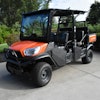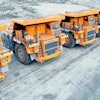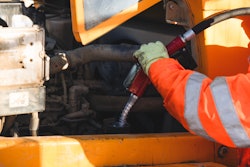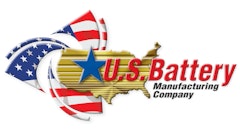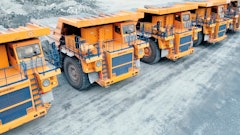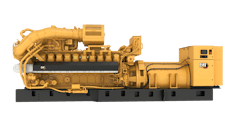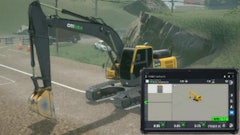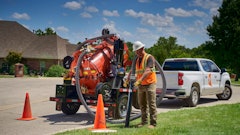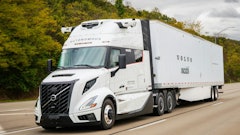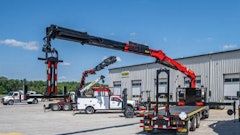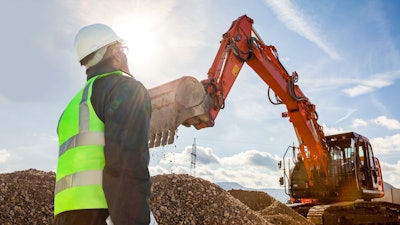
Heavy equipment tools can make the difference between a smooth workday and a pricey disaster. Operating massive machinery worth hundreds of thousands of dollars without proper preparation isn't just unwise — it's dangerous.
The average technician puts $7,500 to $11,000 into their tool inventory, while specialists might spend up to $27,000. This investment pays off through improved safety and efficiency. Complete equipment inspections prevent 80% of catastrophic failures and cut annual maintenance costs by $150,000 per machine.
Our years in the field have taught us that even the best-run diesel shops can be dangerous places filled with loud sounds and bright lights. We created this guide to give you the must-have heavy equipment tools every operator should have available. The right heavy duty equipment tools help minimize downtime and boost productivity. You'll learn about personal protective equipment to stay safe and the best tools to handle emergency repairs.
Personal Protective Equipment (PPE)
The first defense against workplace hazards isn't in your toolbox — it's your personal protective gear. Heavy equipment operators face many dangers each day, from objects falling to dangerous noise levels. PPE acts as a shield against these hazards and prevents serious injuries at work.
PPE Essentials for Heavy Equipment Operators
Every operator needs basic protective gear to stay safe on the job site. OSHA states that all PPE should be well-designed, maintained properly and fit well to make sure workers use it consistently.
Essential PPE items include:
- Hard Hats – These protect against falling objects, impacts and electrical hazards. Look for ANSI-compliant models with good suspension systems. You need to replace these safety items when the UV indicator turns white, which shows sun damage.
- Eye Protection – Safety glasses or goggles protect your eyes from dust, dirt and debris. The best models come with anti-fog coatings and tough, shatter-resistant lenses.
- Hearing Protection – Earplugs or earmuffs help prevent hearing damage from loud machinery. Pick options with high noise reduction ratings (NRR) since many construction sites are louder than safe levels.
- Gloves – These protect your hands from cuts, scrapes, punctures and heat. Good gloves also help you grip and control equipment better.
- Steel-Toed Boots – You need these to prevent foot injuries from falling objects. The right footwear meets ASTM F-2412-2005 and F-2413-2005 standards.
- High-Visibility Clothing – Reflective vests or jackets help others see you on busy sites, which is crucial near traffic or moving equipment.
- Respiratory Protection – Masks or respirators filter out harmful particles, dust and fumes that you often find around heavy equipment.
Some jobs might need extra gear like face shields, special respirators or chemical-resistant clothing based on specific risks.
Why PPE is Critical for Safety and Compliance
PPE isn't just optional — it's the law and vital for staying safe. OSHA requires employers to provide proper PPE and make sure workers use it when other safety measures aren't enough.
Construction work makes up about 19.25% of all job-related deaths, which shows why proper PPE can save lives. The global PPE market is worth USD 75.4 billion in 2023, showing how important safety has become across industries.
PPE does several important things beyond meeting legal requirements:
- Creates barriers between you and hazards
- Stops accidents from common site dangers
- Protects you from long-term health issues
- Makes it easier to see and communicate with other workers
Your employer must check for hazards, provide PPE at no cost and training for how to use it. Training covers when you need PPE, what type works best, how to wear it, its limits and how to take care of it.
PPE is your last defense against worksite dangers. Starting good PPE habits early will keep you safe throughout your career.
Must-have Hand Tools for Heavy Equipment Operators
Heavy equipment operators should keep quality hand tools ready to fix common mechanical problems. While mechanics might spend $7,500 to $27,000 on complete tool collections, operators need a smaller set of versatile tools.
Essential tools for operators include:
- Socket Sets - A combination of ¼-inch, ⅜-inch, and ½-inch square drive socket sets with various accessories forms the foundation of any repair toolkit. Sets should have both standard and deep sockets in metric and SAE sizes.
- Wrenches - Combination wrenches, adjustable wrenches, and Allen wrench sets let you reach fasteners in tight spaces. The snap-on adjustable wrenches (models PWZ2 and PWZ3) are great at gripping hydraulic fittings without causing damage.
- Pliers - Needle nose pliers, slip joint pliers, vise grip-type locking pliers and diagonal cutting pliers handle everything from gripping to cutting. Water pump pliers (15-inch) work great for larger fittings.
- Screwdrivers - A good set needs at least three Phillips and three regular blade screwdrivers. Magnetic screwdrivers help prevent dropped fasteners in tough spots.
- Hammers - Keep both 16oz and 24oz ball peen hammers for general striking tasks. Many operators also carry a dead blow hammer to protect sensitive parts.
- Pry Bars - Mechanic-type pry bars help separate parts and give you leverage. You can't work without them when parts get stuck or need alignment.
- Specialty Items - A telescoping magnetic pickup tool will save you lots of headaches when bolts or sockets fall into tight spots. A digital multimeter helps you check electrical systems quickly.
Heavy equipment needs specific tools like torque wrenches (around 250 ft-lbs capacity), feeler gauge sets, cold chisel sets and aligning punches. These tools help with unique maintenance needs of bigger machines.
Common Repair Scenarios Where Hand Tools Are Vital
My career has shown me several situations where the right tools prevent costly downtime. These problems come up time and again.
Hydraulic line problems top the list of common issues. Stuck hydraulic fittings need specialized tools like the SO ph3050 to tap the hex edge until it breaks free, which saves the hose without cracking the fitting or using heat. Good wrenches protect hydraulic connections from damage.
Basic diagnostic tools help fix electrical systems. A reliable multimeter spots problems with switches, solenoids and wiring before they cause total failure. Colored wire or zip ties help mark wires, fittings and hoses during complex repairs.
Track work is another regular task. The right size wrenches help adjust tension correctly to avoid early wear or track problems. Bolt tightening or replacement happens often, especially after high-vibration work.
Loose connections and fasteners create many equipment issues. Quick access to socket sets and wrenches means you can tighten things up before small problems turn serious. Simple hand tools also help with filter changes and fluid checks.
Operator repairs focus on quick fixes to keep working until proper service is available. These temporary fixes cut downtime and stop further damage.
Track Scrapers and Flange Lock Kits Explained
Track scrapers give your undercarriage its first line of defense against wear and tear. These specialized tools knock away mud, rocks and debris that can wear down expensive parts faster. Good scrapers come with hardened edges that can clear packed material without hurting vital components.
Flange lock kits protect hydraulic systems during maintenance work. These clever tools seal off hydraulic lines when you take out things like valves, pumps or cylinders. This keeps dirt out of the system. Equipment operators see fewer hydraulic problems and parts that last longer.
The best flange lock kits give you several perks:
- You can install them with one hand, no extra tools needed
- They work with SAE Code 61, 62, and CAT-style hydraulic flanges
- They're made from light, strong T6511 anodized aluminum
- Different sizes are color-coded so you can spot them easily in the field
"I've found that Master Kits containing multiple flange lock tools provide the best value," notes veteran operator Jim Reynolds. "Having two of each common size plus singles of smaller and larger sizes covers virtually any hydraulic connection you'll encounter."
These systems do more than keep dirt out - they stop environmental spills that can lead to expensive cleanups and possible fines. A small investment in these specialized tools saves you from big expenses later.
How Undercarriage Tools Extend Equipment Lifespan
The right measurement tools help operators spot wear patterns before they turn into major breakdowns. Your machine's weight sits on the undercarriage while it fights against rocks, rough soil and heavy impacts. Finding problems early makes a big difference.
These tools help you catch small issues before they grow into big headaches. A detailed field measurement kit lets operators get accurate wear percentages. This turns gut feelings into solid data-backed choices.
You can also compare wear between left and right undercarriage parts. Uneven wear often points to alignment issues or problems with operating technique. Catching these differences early saves thousands in repairs. Regular cleaning plus these specialized tools can add hundreds of hours to your undercarriage's life.
Best Practices for Undercarriage Inspections
Regular checks are the lifeblood of good undercarriage maintenance. You should do visual checks weekly or every 40 operating hours. Full measurements work best between 1,000 to 2,000 operating hours.
Clean everything well before you inspect it. This takes time but shows early warning signs you might miss otherwise. Even a little buildup speeds up wear by creating more friction between moving parts.
A good inspection follows these steps:
- Take a step back and look for anything that seems off
- Check each side on its own and write down what you find
- Look at track tension and adjust it to match what the manufacturer says
- Watch for oil leaks from rollers, idlers and drive motors
- Search for loose or missing track bolts, pads or other parts
- Look at wear patterns on both sides to catch alignment problems
Track tension needs change based on conditions. Looser tracks usually work better in soft, muddy or sandy spots. The right tension stops extra wear during normal use.
The equalizer bar and pivot points need extra attention during checks. These vital parts let the machine move side to side. Problems here can mean big repair bills. Operators who stick to a regular inspection routine catch issues long before they cause downtime or need expensive new parts.
Last thing to think about - match your tracks to where you work. Wide tracks float better on soft ground. Narrow tracks give you more pressure and grip when you need it. The right setup for your typical work environment helps your undercarriage last by a lot.
Modern heavy equipment technology just needs specialized diagnostic tools and clear communication methods to work safely and efficiently. My years in the field have taught me that finding problems early can prevent catastrophic failures and costly repairs.
Top Diagnostic Tools for Preventive Maintenance
Diagnostic equipment acts as an early warning system for heavy machinery issues. Professional mechanics invest in complete diagnostic solutions that connect directly to electronic control units (ECUs) to analyze systems in detail.
The core team should keep these diagnostic tools ready:
Software diagnostic applications vary from simple code readers to advanced programs. While simple on-board diagnostic (OBD) II scanners interpret diagnostic trouble codes, advanced applications like Noregon's JPRO provide complete data analysis with features such as enhanced fault descriptions, bidirectional commands and aftertreatment diagnostics.
Telematics systems make use of remote technology to track entire fleets and deliver up-to-the-minute data on performance, equipment status, and location. These systems monitor critical metrics including speed, usage, fuel consumption and idle time.
Specialized testing equipment typically has:
- Multimeters to measure electrical properties like current, voltage and resistance
- Battery load testers to analyze battery health completely
- Circuit testers to explore energy quality in wires and components
- Scope meters to display current waveforms in real time
Portable fluid analysis kits help test particulates on-site in as little as ten minutes for hydraulic systems. These kits identify contamination issues before they cause system failures.
Heavy-duty diagnostic scanners are the foundation of modern vehicle diagnostics. They read and clear trouble codes, monitor system health, and even reprogram control modules. Quality diagnostic tools help operators find developing problems long before they cause major downtime.
Emergency and Safety Response Tools
The right emergency equipment can mean the difference between a minor incident and a major disaster. Your preparation for unexpected emergencies goes beyond just following rules – it’s about keeping people safe and protecting your investment in workers and machines.
First Aid Kits and Fire Extinguishers: What to Include
Construction sites need well-stocked first aid kits that meet safety standards. Heavy equipment operators must have Class B first aid kits instead of the simple Class A kits you'd find in offices. Class B kits come with extra supplies to treat the more serious injuries that happen around heavy machinery.
A Class B first aid kit that meets requirements should have:
- 2 triangular bandages and 4 trauma pads
- 4 pairs of medical gloves and 2 eye pads
- Multiple gauze rolls (4" and 2" sizes)
- At least 50 adhesive bandages and 25 antibiotic treatments
- Burn treatments and eye/skin wash
- A tourniquet and splint to treat serious injuries
Fire protection needs specific types of extinguishers based on the vehicle's weight and working conditions. Equipment between 10,000 and 26,000 pounds needs at least a 2½ lb ABC-type extinguisher rated at 1A:10BC. Larger equipment or machines working near combustible materials must have at least a 10 lb ABC-type extinguisher rated at 4A:60BC.
The best fire extinguishers for heavy equipment use clean agent technology that:
- Works without conducting electricity or causing corrosion
- Disappears without leaving residue
- Puts out fires without damaging sensitive parts
STOP-FYRE extinguishers work well in temperatures from -40°F to +120°F, making them suitable for many work environments.
Emergency Preparedness Tips for Operators
You need detailed emergency plans before anything goes wrong. Start by setting up a clear chain of command and naming who can order evacuations or equipment shutdowns.
Your worksite's evacuation procedures should include:
- Safe meeting spots away from equipment
- Clear paths that stay free of obstacles
- Ways to help visitors or workers who need special assistance
Practice drills help everyone remember these procedures. You should also pick and train floor wardens to sound alarms and help with evacuation. These wardens need backups in case they're not available.
Heavy equipment operation comes with unique risks, so your emergency plan must cover different scenarios like fires, floods, equipment rollovers and hazardous spills. Each situation might need a different response – you might need to stay put or evacuate quickly.
Ready for Anything
Preparedness sets professional operators apart. The right PPE, hand tools, undercarriage maintenance tools, diagnostic gear and emergency equipment keep worksites safe, minimize downtime and extend machine life. Quality tools require an upfront investment, but they pay off through lower maintenance costs, longer equipment lifespan and safer operations. A well-stocked toolkit is not just about convenience, it reflects a commitment to safety, efficiency and professionalism on every job site.


